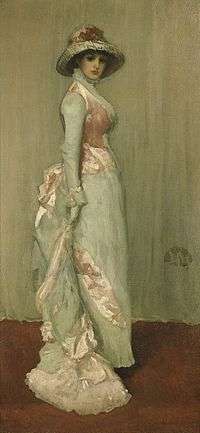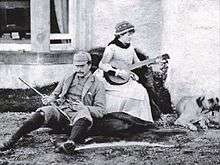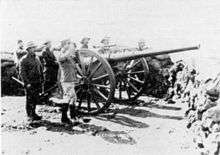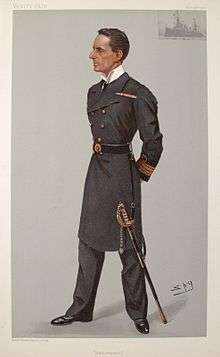Valerie, Lady Meux
Valerie Susan, Lady Meux (pronounced "Mews";[1] née Langdon; 1847–1910), was an American-born English socialite of the Victorian era. She was the wife of Sir Henry Bruce Meux, 3rd Baronet (1856–1900), a London brewer.

Whistler
James Abbott McNeill Whistler painted three portraits of Lady Meux in 1881. The portraits were the first full-scale commissions to be given to Whistler following the notorious Ruskin trial, which had left him financially bankrupt. Harmony in Pink and Grey: Portrait of Lady Meux currently belongs to the Frick Collection in New York City, Arrangement in Black: Lady Meux belongs to the Honolulu Museum of Art while the third portrait, Portrait of Lady Meux in Furs, is believed to have been destroyed by Whistler after he became outraged over a comment made to him by Lady Meux during a sitting.[2]
Married life

Lady Meux claimed to have been an actress, but was apparently on the stage for only a single season.[3] She is believed to have met Sir Henry at the Casino de Venise in Holborn, where she worked as a banjo-playing barmaid and prostitute under the name Val Reece.[4][5]
Never accepted by her husband's family or by polite society, Lady Meux was a flamboyant and controversial figure, given to driving herself around London in a high phaeton, drawn by a pair of zebras.[6] Their house at Theobalds in Hertfordshire was lavishly improved and enlarged; additions included a swimming pool and an indoor roller skating rink.[7] In 1887, at Lady Meux's request, the dismantled Temple Bar was purchased from the City of London Corporation, transported to Hertfordshire and carefully rebuilt as a new gateway to the estate. She often entertained in the upper chamber of the gateway. Guests included the Prince of Wales and Winston Churchill.[7] Sir Henry died in 1900, without issue, ten years before she did.[8]
Interests
Lady Meux also owned a string of race horses, racing them under the assumed name of Mr. Theobolds. As an owner she was not greatly successful, but she won the Sussex Stakes with Ardeshir in 1897.[9] She was also a noted collector of ancient Egyptian artefacts; the Egyptologist Wallis Budge, published a catalogue of more than 1,700 of her items including 800 scarabs and amulets. He dedicated his publication, The Book of Paradise, to her. She tried to leave the collection to the British Museum, but the trustees declined the bequest and it was sold. She also acquired five illustrated Ethiopic manuscripts, and Budge published a coloured facsimile of them. On finding that they were revered by the Ethiopians, she left them in her will to Emperor Menelik. The courts set aside this provision, ostensibly, to keep them in Britain - and they were sold to William Randolph Hearst, of California.[10]
The Boer War

During the Second Boer War, the early British reverses made headline news and the defence of Ladysmith made a particular impression on Lady Meux. On hearing of the landing of naval guns for the Battle of Ladysmith,[11] she ordered, at her own expense, six naval 12-pounders on special field carriages made by Armstrong of Elswick. The guns were sent directly to Lord Roberts in South Africa, because they had been refused by the War Office. The unit which manned these guns were known as the "Elswick Battery". The battery was in action several times, including the Second Battle of Silkaatsnek.[12][13]
Sir Hedworth Lambton

When Sir Hedworth Lambton, the commander of the Naval Brigade at Ladysmith, returned to England, he called on Lady Meux at Theobalds to thank her for her gift and recount his adventures. She was so taken with him that she made him the chief beneficiary of her will, on condition that he change his surname to Meux (she was without direct heirs). When she died on 20 December 1910, he willingly changed his name by Royal Warrant,[14] and inherited the Hertfordshire estate and a substantial interest in the Meux Brewery.[15]
References
- "Mereworth to Naas". Retrieved 20 December 2014.
- The Correspondence of James Mcneill Whistler - Valerie Susan Meux
- Frick Collection, The Frick Collection, An Illustrated Catalogue, Vol. 1, Paintings: American, British, Dutch, Flemish, and German, New York, Frick Collection, p. 18, ISBN 0-691-03811-2.
- Bradburn, Elizabeth, Margaret McMillan: Portrait of a Pioneer, London, Routledge, 1989, p. 29.
- Glancey, Jonathan, Temple of Doom, The Guardian, Wednesday 17 November 2004.
- "The Third Family of Captain John Francis Hyde". Retrieved 20 April 2018.
- "Theobalds Park". Archived from the original on 14 January 2011. Retrieved 20 December 2014.
- "Oxford University Press - OUP - UK Official Home Page of Oxford University Press - Oxford Books". Retrieved 20 December 2014.
- "Horseracing Online - Profile Unavailable". Retrieved 20 December 2014.
- "Virtual Egyptian Museum - The Full Collection". Retrieved 20 December 2014.
- "British Weaponry".
- "Elswick Battery". Anglo-Boer War.
- "Northumberland Artillery". Retrieved 20 December 2014.
- "- Person Page 2748". Retrieved 20 December 2014.
- "History In Portsmouth". Archived from the original on 5 March 2012. Retrieved 20 December 2014.
External links
![]()